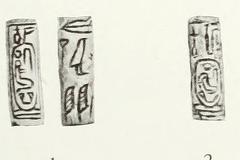Top Qs
Timeline
Chat
Perspective
Sedjefakare Kay Amenemhat VII
Egyptian pharaoh of the 13th Dynasty From Wikipedia, the free encyclopedia
Remove ads
Sedjefakare Kay Amenemhat VII was an Egyptian pharaoh of the early 13th Dynasty in the late Middle Kingdom.
Remove ads
Attestations
Summarize
Perspective
Archaeologically, he is known from several objects, including six cylinder seals,[2]and two scarab seals.[3] His name appears as graffito in the tomb of queen Khuit I at Saqqara.
Architecture
Bark-stand, Cairo JE 15900
At Medamud (Upper Egypt), a bark-stand which originally had an inscription of Sedjefakare to which an inscription was added by Wegaf.[4] In the Turin King List Wegaf (7:05) heads this sequence of kings while Sedjefakare (7:17) comes later in the list, causing a debate about the chronology of these kings.
Nile Level Record
At Semna (Nubia), a Nile Level Record is dated to Year 1.[5] Other kings with Nile Level records at the fortresses of Semna and Kumma includes Amenemhat III, Amenemhat IV, Sobekneferu, Sekhemkare Amenemhat V and Sekhemre Khutawy Sobekhotep Amenemhat.
Cylinder seals
Six cylinder seals are known.[6]
Cylinder Seal, Petrie UC 11533
At Harageh (Faiyum region), a cylinder seal with the inscription: Sedjefakare, beloved by Sobek lord of Sumenu.[7]
Cylinder Seal, Petrie UC 11534
At Lahun (Faiyum region), a cylinder seal with the inscription: Sedjefakare, beloved by Sobek lord of Sumenu.[8]
Cylinder Seal, New York MMA 10.130.1640


A glaced steatite cylinder seal with the Horus name Horteptawy/Heriteptawy, belonging to Amenemhat VII[9][10]
Scarabs
Two scarabs are known.[11]
Scarab, New York MMA 26.7.85

Scarab With Throne Name Sedjefakare, belonging to Amenemhat VII.[12][13]
Remove ads
Non-Contemporary Attestations
The Turin King List 7:18 contains the entry: "The Dual King Sedjefa..kara, x years ...".[14] In the list he is predeceded by 7:17 Awtibra Hor and succeeded by 7:19 Sekhemre Khutawy Sobekhotep Amenemhat.
Burial
The Tomb of Sedjefakare has not been located.
Theories
Ryholt assigns him without further evidence a reign of 3 years.[15] He suggests a dating around 1769-1766 BC.
Bibliography
- K.S.B. Ryholt, The Political Situation in Egypt during the Second Intermediate Period (Carsten Niebuhr Institute Publications, vol. 20. Copenhagen: Museum Tusculanum Press, 1997), 341, File 13/20.
See also
Wikimedia Commons has media related to Kay Amenemhat Sedjefakare.
References
Wikiwand - on
Seamless Wikipedia browsing. On steroids.
Remove ads


